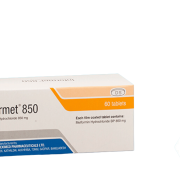Centomin Tablet
Metformin Hydrochloride
500 mg
Centeon Pharma Ltd.
Unit Price: ৳ 4.00 (10 x 10: ৳ 400.00)
Strip Price: ৳ 40.00
Indications
Centomin tablet is indicated for the treatment of type 2 diabetes mellitus, particularly in overweight patients when dietary management and exercise alone does not result in adequate glycaemic control.
- In adults: Centomin may be used as monotherapy or in combination with other oral antidiabetic agents or with insulin.
- In children from 10 years of age and adolescents: Centomin may be used as monotherapy or in combination with insulin.
A reduction of diabetic complications has been shown in overweight type 2 diabetic adult patients treated with metformin as first-line therapy after diet failure.
Pharmacology
Metformin is a biguanide type oral antihyperglycemic drug used in the management of type 2 diabetes. It lowers both basal and postprandial plasma glucose. Its mechanism of action is different from those of sulfonylureas and it does not produce hypoglycemia. Metformin decreases hepatic glucose production, decreases intestinal absorption of glucose and improves insulin sensitivity by an increase in peripheral glucose uptake and utilization.
Dosage & Administration
Metformin immediate release tablet: Dosage of Metformin Hydrochloride must be individualized on the basis of both effectiveness and tolerance, while not exceeding the maximum recommended daily doses.
- Adult: The usual starting dose of Metformin is 500 mg twice a day or 850 mg once a day, given with meals. Dosage increases should be made in increments of 500 mg weekly or 850 mg every 2 weeks, up to a total of 2000 mg per day, given in divided doses. For those patients requiring additional glycemic control, Glucomin may be given to a maximum daily dose of 2550 mg per day. Doses above 2000 mg may be better tolerated given three times a day with meals.
- Children: The usual starting dose of Metformin is 500 mg twice a day, given with meals. Dosage increases should be made in increments of 500 mg weekly up to a maximum of 2000 mg per day, given in divided doses.
Metformin extended release tablet: Swallow Metformin XR tablet whole and never crush, cut or chew.
- Adult: The usual starting dose of Metformin XR is 500 mg once daily with the evening meal. Dose should be increased in increments of 500 mg weekly, up to a maximum of 2000 mg once daily with the evening meal, alternatively increased to 1000 mg twice daily taken with meal. Patient receiving Metformin immediate release tablet may be switched to Metformin extended release tablet up to a maximum recommended daily dose.
- Children: Metformin extended release tablet has not been studied in children.
- Renal impaired patient: Do not use Metformin in patients with eGFR below 30 mL/min/1.73 m2. Asses risk/benefit of counting if eGFR falls below 45 mL/min/1.73 m2.
* রেজিস্টার্ড চিকিৎসকের পরামর্শ মোতাবেক ঔষধ সেবন করুন‘
Interaction
No information is available about the interaction of Centomin and Furosemide when co-administered chronically. Nifedipine appears to enhance the absorption of Centomin. Centomin had minimal effects on Nifedipine. Cationic drugs (e.g., Amiloride, Digoxin, Morphine, Procainamide, Quinidine, Quinine, Triamterene, Trimethoprim, or Vancomycin) that are eliminated by renal tubular secretion theoretically have the potential for interaction with Centomin by competing for common renal tubular transport systems. Centomin had no effect on Cimetidine pharmacokinetics. Certain drugs tend to produce hyperglycemia and may lead to loss of glycemic control. These drugs include the thiazides and other diuretics, corticosteroids, phenothiazines, thyroid products, Estrogens, Oral contraceptives, Phenytoin, Nicotinic Acid, sympathomimetics, calcium channel blocking drugs, and Isoniazid.
Contraindications
- Hypersensitivity to the active substance or to any of the excipients.
- Any type of acute metabolic acidosis (such as lactic acidosis, diabetic ketoacidosis).
- Severe renal failure (GFR <30 mL/min).
- Acute conditions with the potential to alter renal function such as: dehydration, severe infection, shock.
- Acute or chronic disease, which may cause tissue hypoxia such as: cardiac or respiratory failure, recent myocardial infarction, shock, Hepatic insufciency, acute alcohol intoxication, alcoholism.
Side Effects
Blood and lymphatic system disorders: Not known: Hemolytic anemia
Metabolism and nutrition disorders: Very rare: Lactic acidosis. Decrease of vitamin B12 absorption with a decrease of serum levels during long-term use of metformin. Consideration of such etiology is recommended if a patient presents with megaloblastic anemia. Cases of peripheral neuropathy in patients with vitamin B12 deficiency have been reported in post-marketing experience (frequency not known)
Nervous system disorders: Common: Taste disturbance. Not known: Encephalopathy
Gastrointestinal disorders: Very common: Gastrointestinal disorders, such as nausea, vomiting, diarrhea, abdominal pain, and loss of appetite. These undesirable effects occur most frequently during the initiation of therapy and resolve spontaneously in most cases. To prevent them, it is recommended that metformin be taken in 2 or 3 daily doses during or after meals. A slow increase of the dose may also improve gastrointestinal tolerability.
Hepatobiliary disorders: Very rare: Isolated reports of liver function test abnormalities or hepatitis resolving upon metformin discontinuation.
Skin and subcutaneous tissue disorders: Very rare: Skin reactions, such as erythema, pruritus, urticaria.
Pregnancy & Lactation
Pregnancy: Uncontrolled diabetes during pregnancy (gestational or permanent) is associated with an increased risk of congenital abnormalities and perinatal mortality. When the patient plans to become pregnant and during pregnancy, it is recommended that diabetes is not treated with metformin but insulin be used to maintain blood glucose levels as close to normal as possible, to reduce the risk of malformations of the foetus.
Breastfeeding: Metformin is excreted into human breast milk. No adverse efects were observed in breastfed newborns/infants. However, as only limited data are available, breastfeeding is not recommended during metformin treatment. A decision on whether to discontinue breastfeeding should be made, taking into account the benefit of breastfeeding and the potential risk to adverse effects on the child.
Precautions & Warnings
Centomin is known to be substantially excreted by the kidney and the risk of Centomin accumulation and lactic acidosis increases with the degree of impairment of renal function. Centomin may lower vitamin B12 level. It also increases risk of hypoglycemia when use in combination with insulin or insulin secretagogue.
Centomin is excreted by the kidney and regular monitoring of renal function is advised in all diabetics. Centomin therapy should be stopped 2-3 days before surgery and clinical investigations such as intravenous urography and intravenous angiography, and reinstated only after control or renal function has been regained. The use of Centomin is not advised in conditions which may cause dehydration or in patients suffering from serious infections or trauma. Patients receiving continuous Centomin therapy should have an annual estimation of Vitamin B-12 levels because of reports of decreased Vitamin B-12 absorption. During concomitant therapy with a sulphonylurea, blood glucose should be monitored because combined therapy may cause hypoglycaemia. Stabilization of diabetic patients with Centomin and insulin should be carried out in hospital because of the possibility of hypoglycaemia until the correct ratio of the two drugs has been obtained. Reduced renal clearance of Centomin has been reported during cimetidine therapy, so a dose reduction should be considered. As with a number of drugs, an interaction between Centomin and anticoagulants is a possibility and dosage of the latter may need adjustment.
Use in Special Populations
Elderly: Due to the potential for decreased renal function in elderly subjects, the metformin dosage should be adjusted based on renal function. Regular assessment of renal function is necessary.
Pediatric population: The diagnosis of type 2 diabetes mellitus should be confirmed before treatment with metformin is initiated. No effect of metformin on growth and puberty has been detected during controlled clinical studies of one-year duration but no long-term data on these specific points are available. Therefore, a careful follow-up of the effect of metformin on these parameters in metformin-treated children, especially prepubescent children, is recommended.
Children aged between 10 and 12 years: Particular caution is recommended when prescribing to children aged between 10 and 12 years.
Renal function: As metformin is excreted by the kidney, creatinine clearance (this can be estimated from serum creatinine levels by using the Cockcroft-Gault formula) should be determined before initiating treatment and regularly thereafter:
- At least annually in patients with normal renal function,
- At least two to four times a year in patients with creatinine clearance at the lower limit of normal and in elderly subjects.
Decreased renal function in elderly subjects is frequent and asymptomatic. Special caution should be exercised in situations where renal function may become impaired, for example when initiating antihypertensive therapy or diuretic therapy and when starting therapy with a non-steroidal anti-inflammatory drug (NSAID). GFR should be assessed before treatment initiation and regularly thereafter. Centomin is contraindicate in patients with GFR<30 ml/min and should be temporarily discontinued in the presence of conditions that alter renal function.
Overdose Effects
Hypoglycemia has not been seen with Centomin doses up to 85 gm, although lactic acidosis has occurred in such circumstances. Lactic acidosis is a medical emergency and must be treated in hospital. The most effective method to remove lactate and Centomin is hemodialysis.
Therapeutic Class
Biguanides
Storage Conditions
Keep below 30°C temperature, protected from light & moisture. Keep out of the reach of children.


